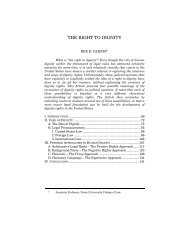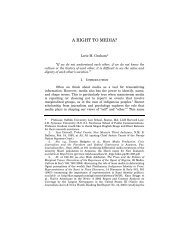CHAPTER 33 - Columbia Law School
CHAPTER 33 - Columbia Law School
CHAPTER 33 - Columbia Law School
You also want an ePaper? Increase the reach of your titles
YUMPU automatically turns print PDFs into web optimized ePapers that Google loves.
Ch. <strong>33</strong> TEMPORARY RELEASE PROGRAMS 907<br />
challenge the legislature or executive’s decision to make you ineligible for temporary release based<br />
upon the crime for which you were convicted, if you have not yet participated in the program. 84<br />
However, it is possible to win, as seen in Lopez v. Coughlin. 85 In that case, an HIV-positive<br />
prisoner applied for work release. The TRC approved the application because the facility doctor,<br />
who was familiar with the prisoner’s condition, said his medical condition would not affect his<br />
ability to be in work release. Central Office reversed and denied the application solely on the basis of<br />
the prisoner’s condition. The Albany County Supreme Court held that this was completely irrational<br />
since the doctor had already given his approval. The court said that Central Office’s findings “were<br />
based on generalizations and possibly inaccurate assumptions” and ordered the TRC to reevaluate<br />
its decision. 86 In Flaherty v. Coughlin, the prisoner alleged that he had been denied temporary release<br />
privileges in retaliation for filing a class action suit. 87 His class action challenged a statewide prison<br />
lockdown, and shortly after filing the suit, Flaherty applied for temporary release privileges. The<br />
TRC accepted him, but the Commissioner of Corrections, whose approval was legally required in<br />
1983 (the time of the suit), reversed the TRC recommendation. Flaherty alleged retaliation and<br />
asked for TRC and Commissioner office documents. The district court dismissed his request, but the<br />
Second Circuit said that because factual evidence existed that retaliation may have been a factor, the<br />
documents Flaherty needed should be given to him so that he could prepare his case. 88<br />
2. Revocation of Temporary Release<br />
(a) How Your Temporary Release Can Be Revoked<br />
Your temporary release may be suspended or revoked by the superintendent or director of your<br />
correctional institution upon recommendation of the TRC or the Commissioner of the Department<br />
of Correctional Services. 89 This suspension or revocation can be made at any time if the<br />
superintendent or director has information that:<br />
(1) Your continued participation in the program is not in the interest of community safety<br />
and goes against your best interests; or<br />
(2) There is a substantial likelihood that you cannot successfully complete the temporary<br />
release program. 90<br />
Some factors which will be considered indicators that you are unsuited for temporary release<br />
include:<br />
(1) Arrest and/or convictions for crimes committed while participating in the program;<br />
84. Lee v. Governor of New York, 87 F.3d 55, 59–60 (2d Cir. 1996) (finding neither an interest in participation in the<br />
temporary release programs for prisoners excluded based on their crime, nor an equal protection or a retroactive<br />
punishment violation); see also Moore v. N.Y.S. Dep’t of Corr. Servs., 26 F.App’x. 32, <strong>33</strong>, 2001 U.S. App. LEXIS 23192, at<br />
*2 (2d Cir. 2001) (unpublished) (holding that the nature of a prisoner’s crime and his failure to accept full responsibility for it<br />
were rational bases for denying petitioner participation in family reunion program and that such denial was therefore not a<br />
violation of due process).<br />
85. See Dorst v. Pataki, 167 Misc. 2d 329, <strong>33</strong>7, 6<strong>33</strong> N.Y.S.2d 730, 735 (2d Cir. 2001) aff’d, 90 N.Y.2d 696, 699, 687<br />
N.E.2d 1348, 1349, 665 N.Y.S.2d 65, 66 (1997) (holding that executive order flatly eliminating all felons from participation<br />
in temporary release programs was unconstitutional, although upholding power of executive to impose other limits on<br />
temporary release participation); see also Flaherty v. Coughlin, 713 F.2d 10, 14 (2d Cir. 1983); Lopez v. Coughlin, 139<br />
Misc. 2d 851, 529 N.Y.S.2d 247 (Sup. Ct. Albany County 1988).<br />
86. Lopez v. Coughlin, 139 Misc. 2d 851, 854, 529 N.Y.S.2d 247, 249 (Sup. Ct. Albany County 1988).<br />
87. Flaherty v. Coughlin, 713 F.2d 10, 11 (2d Cir. 1983).<br />
88. Flaherty v. Coughlin, 713 F.2d 10, 14 (2d Cir. 1983).<br />
89. N.Y. Comp. Codes R. & Regs. Tit. 7, § 1904.1(a) (2001).<br />
90. N.Y. Comp. Codes R. & Regs. Tit. 7, § 1904.1(b) (2001).















